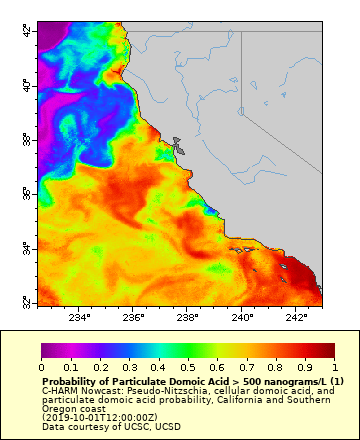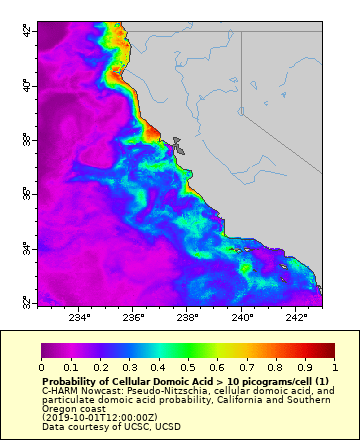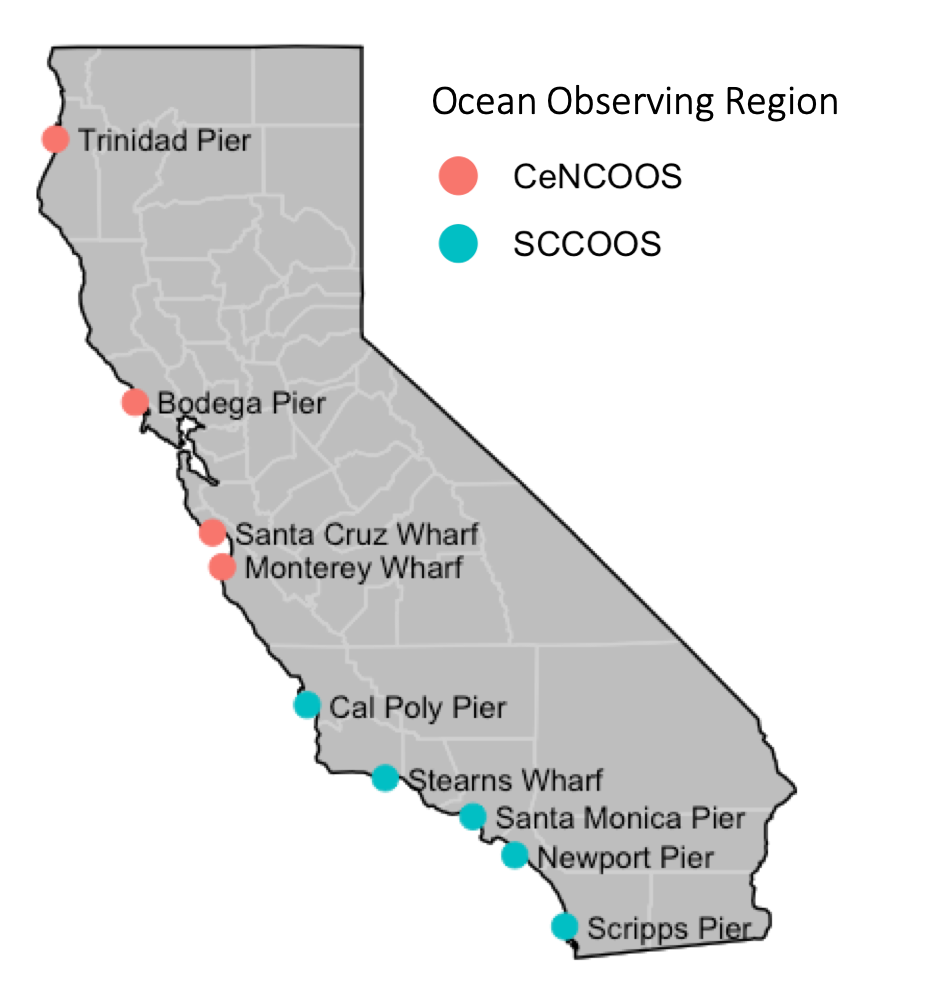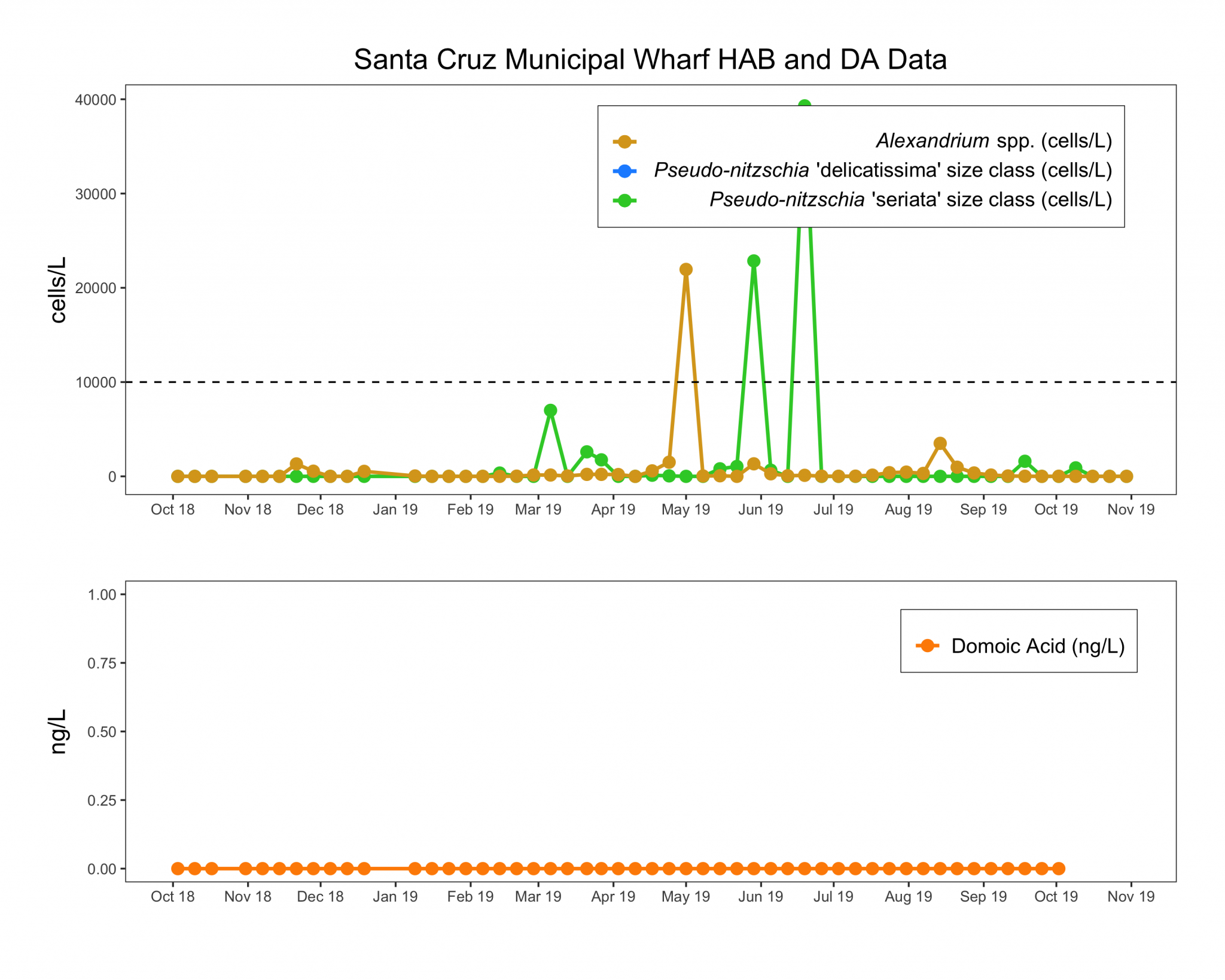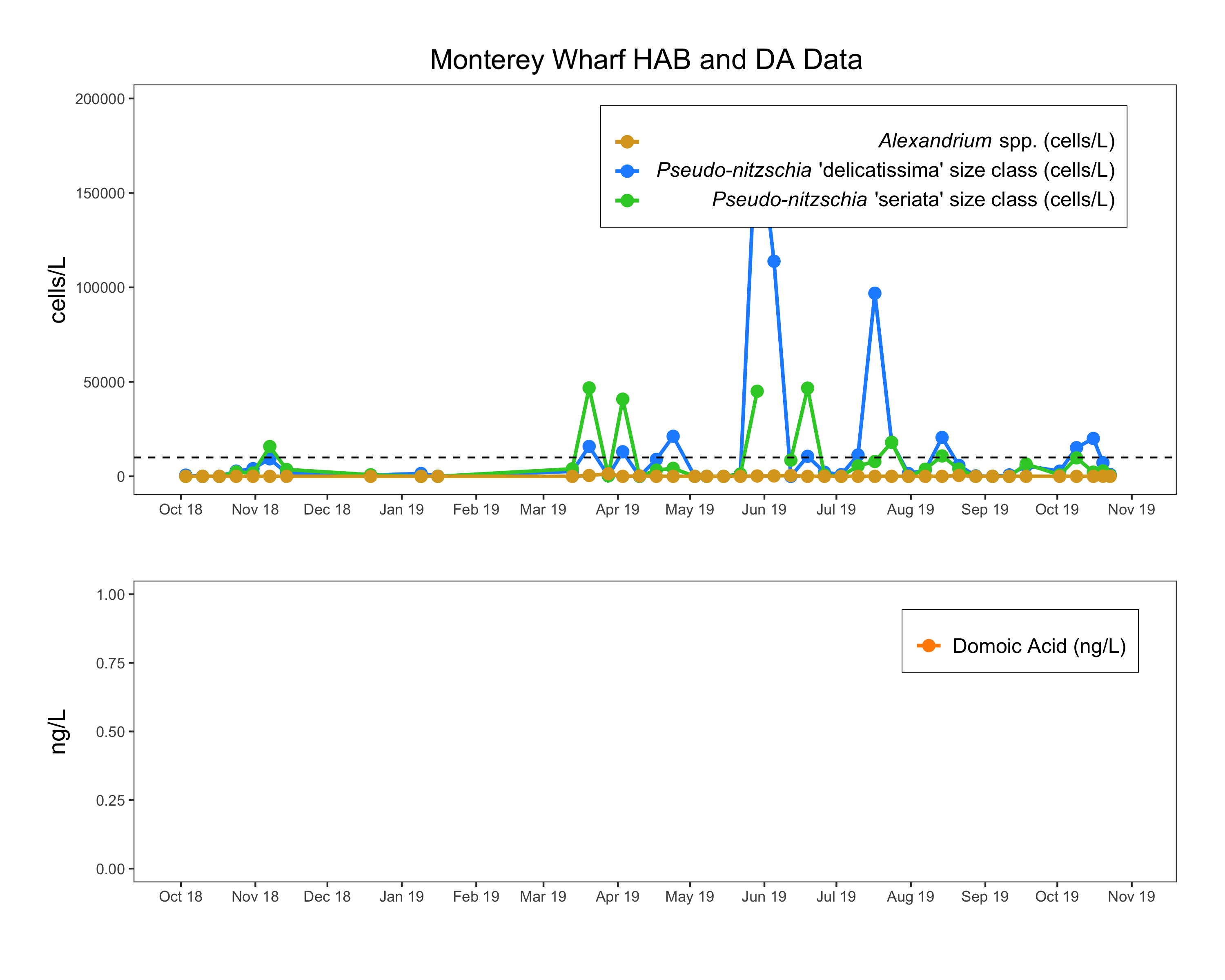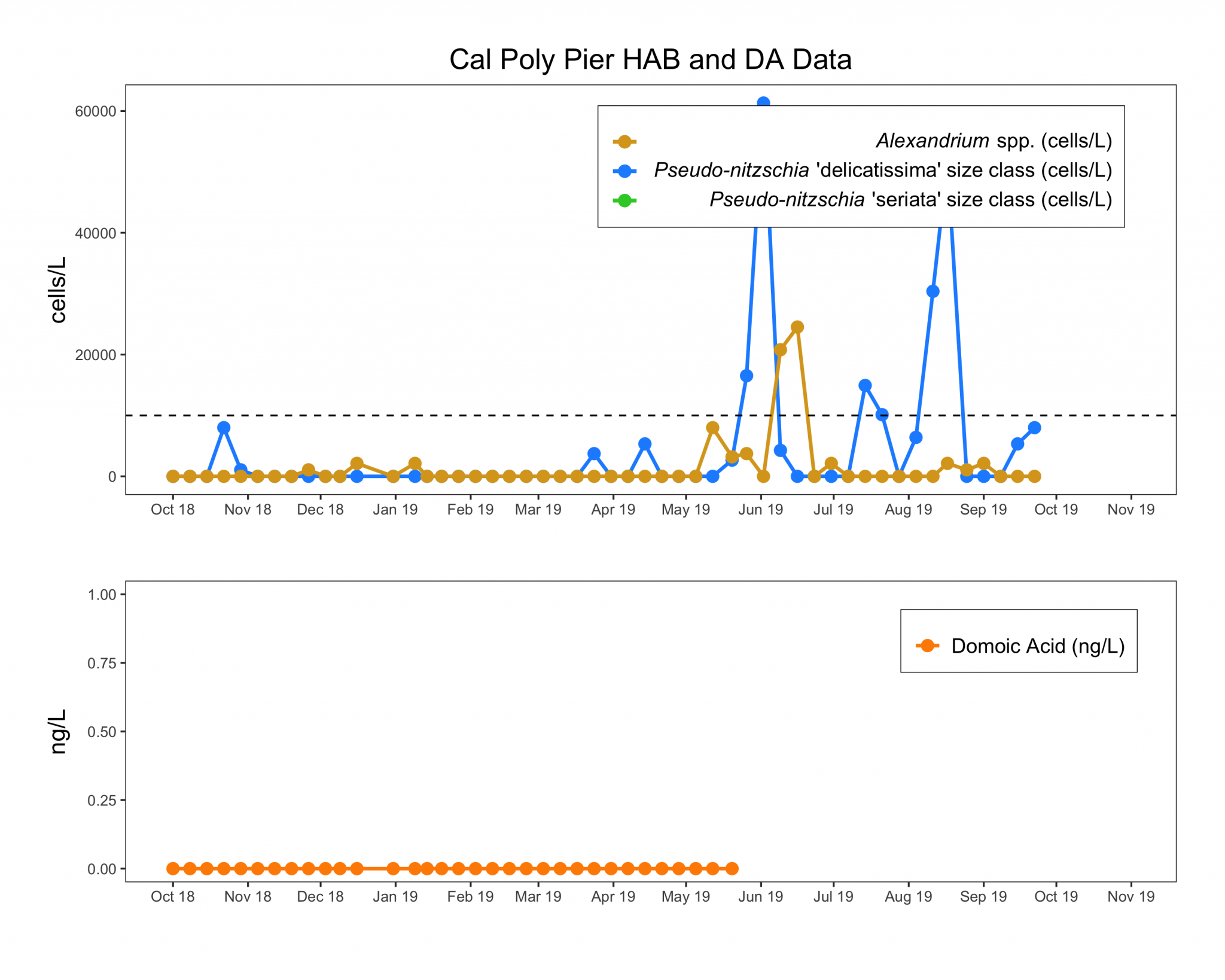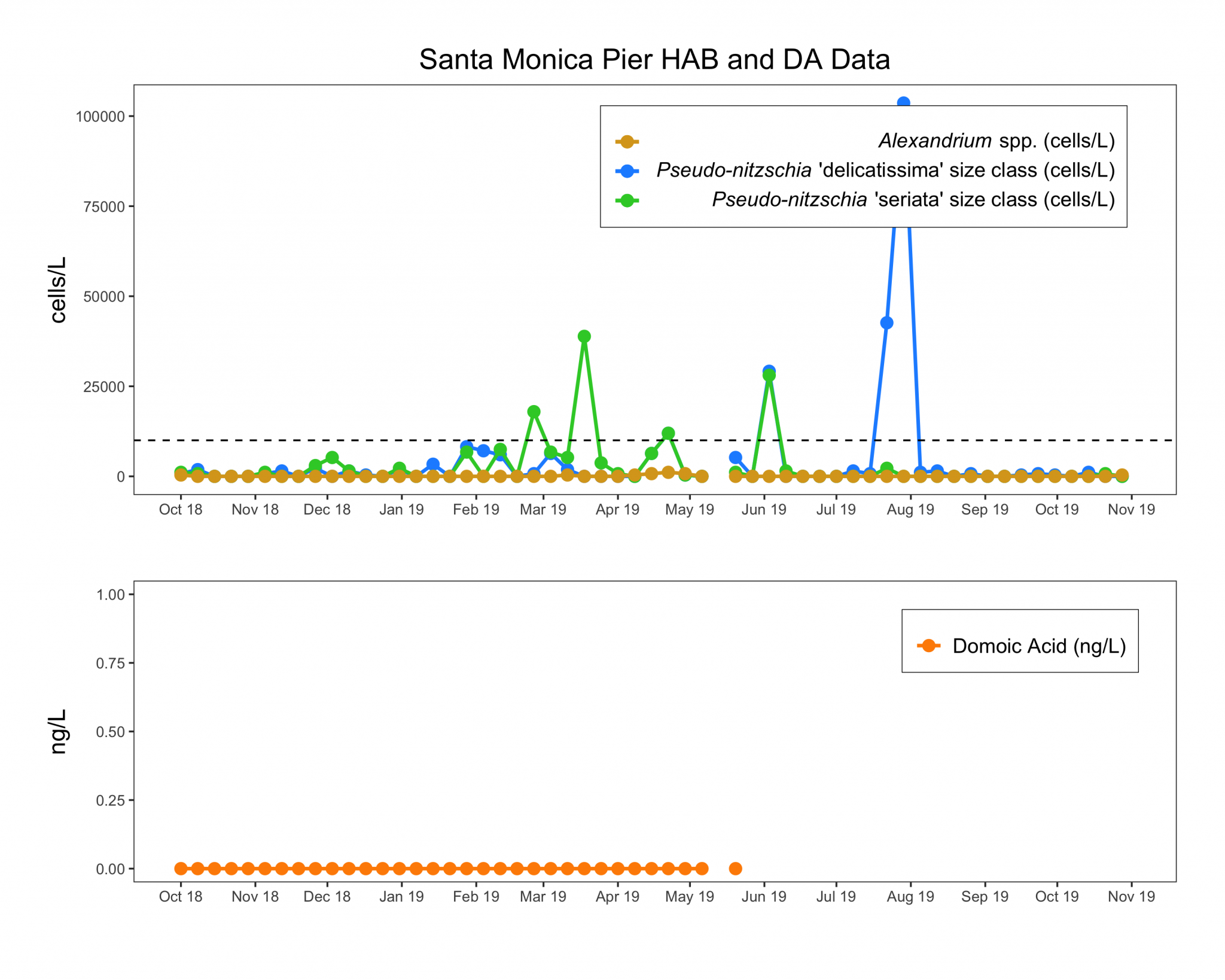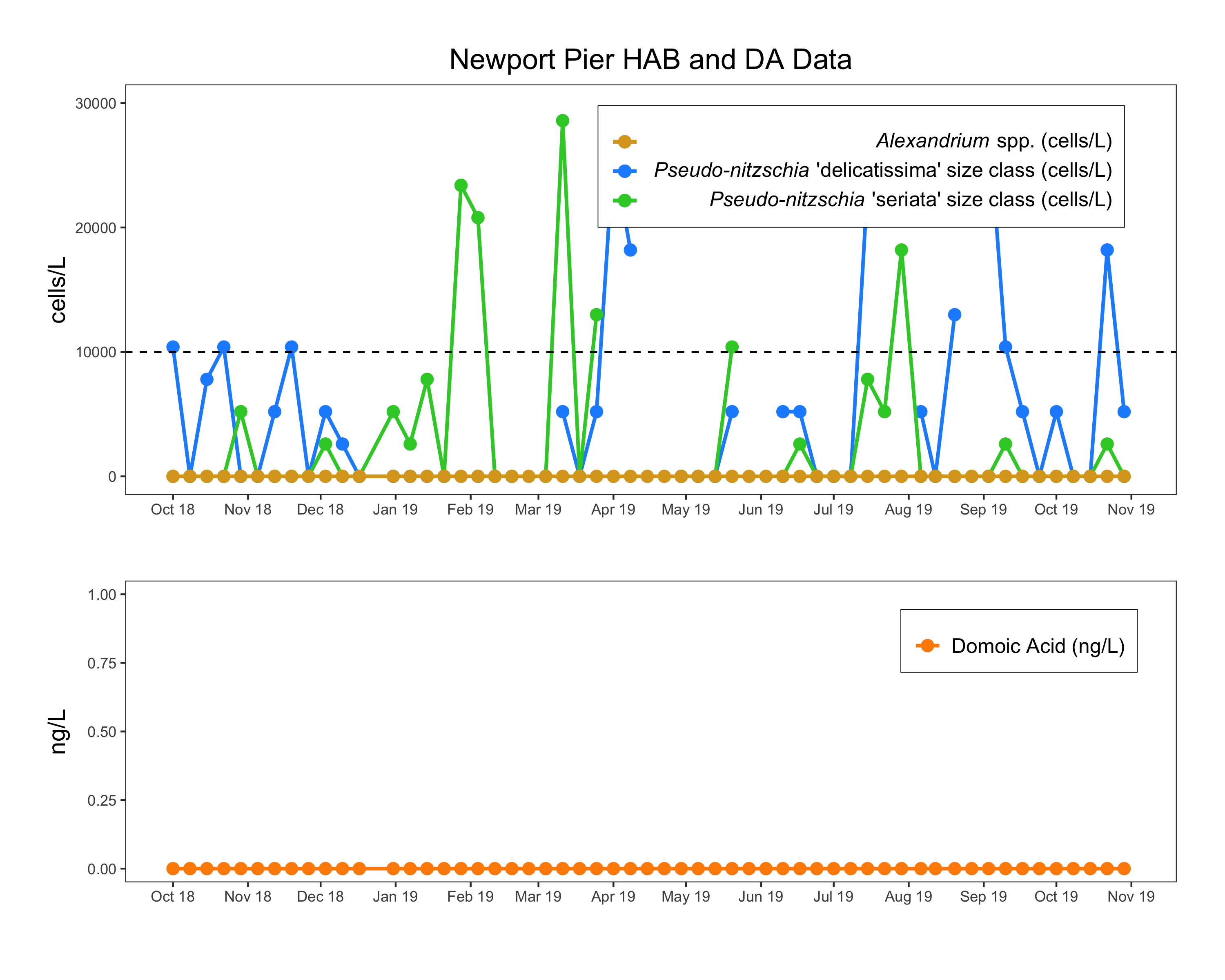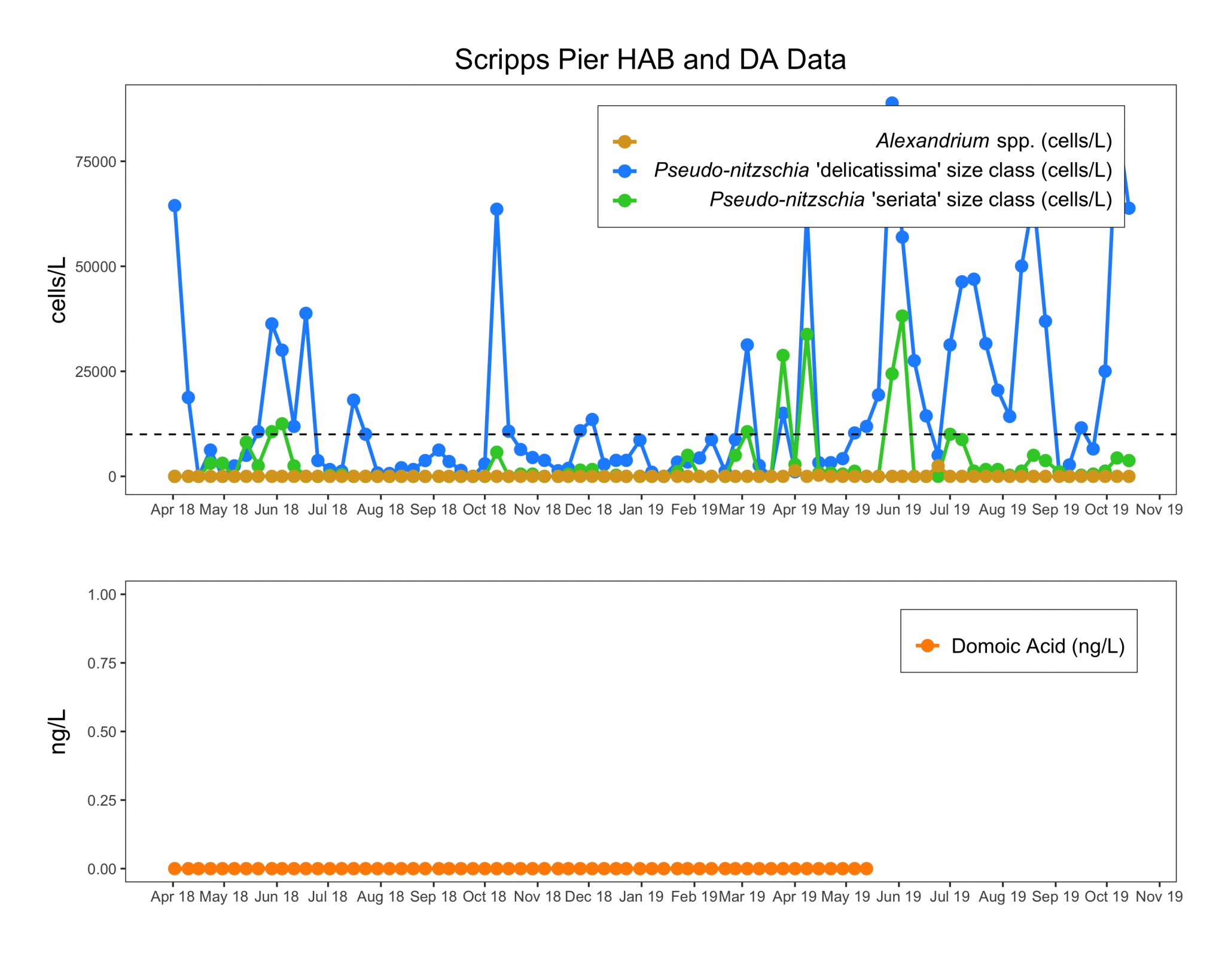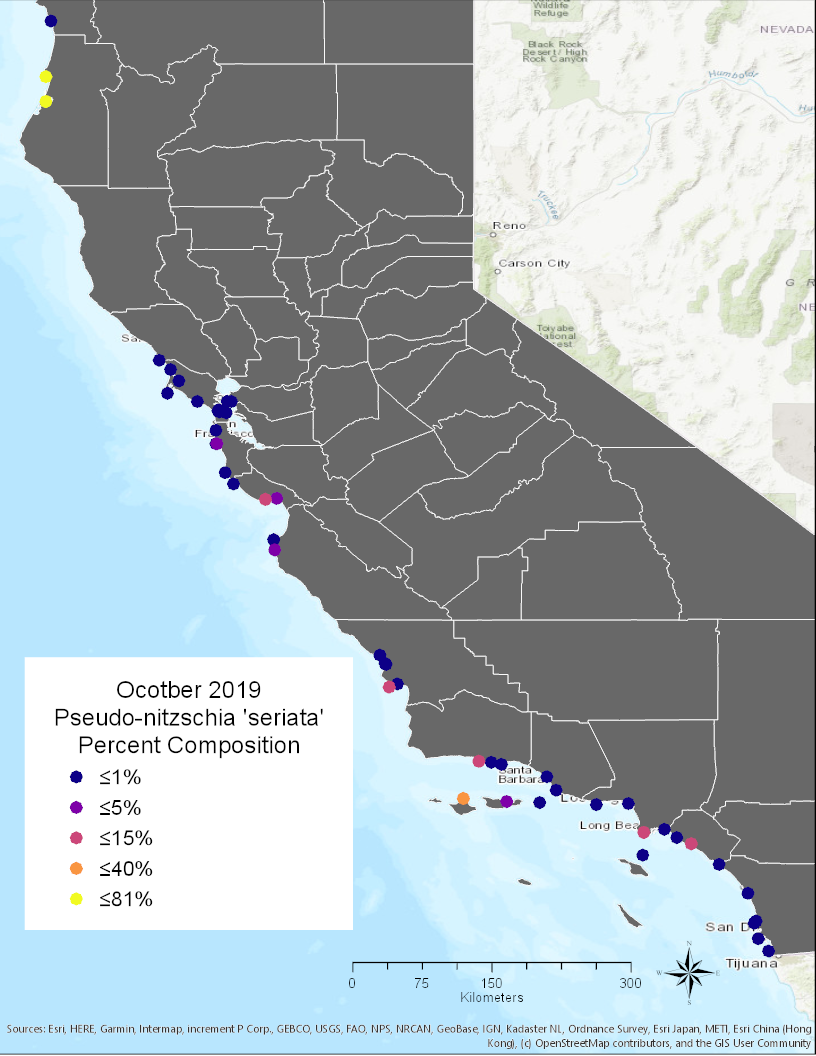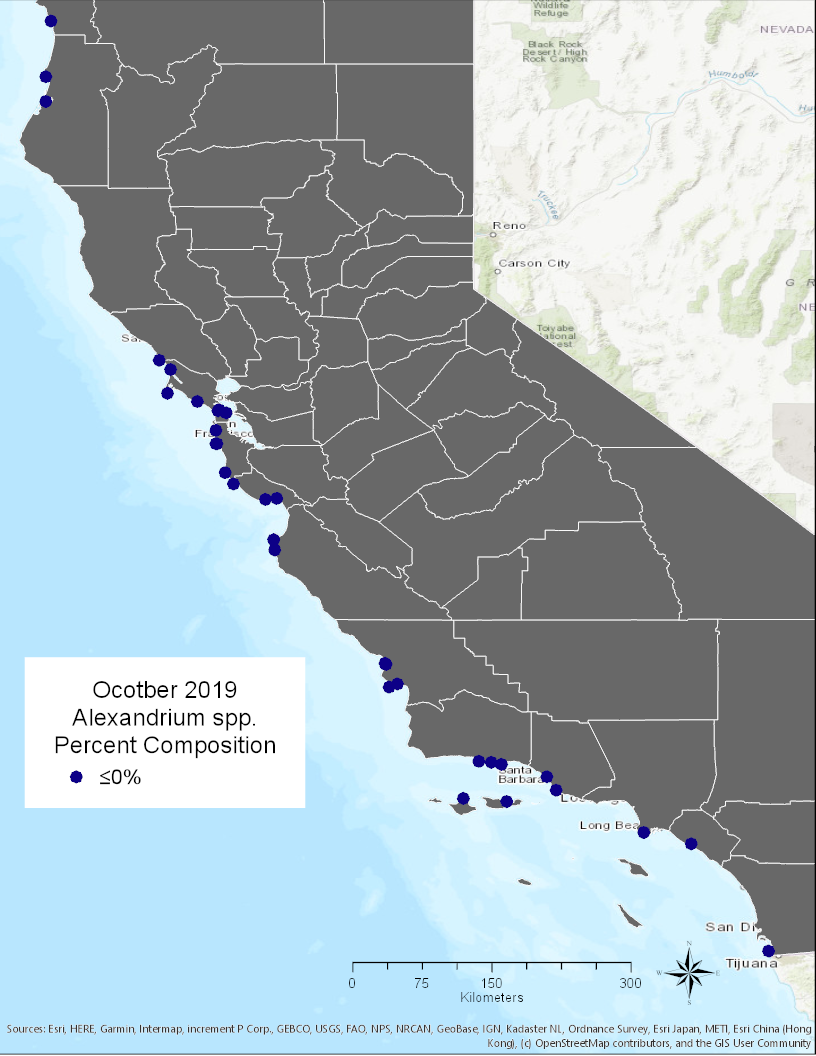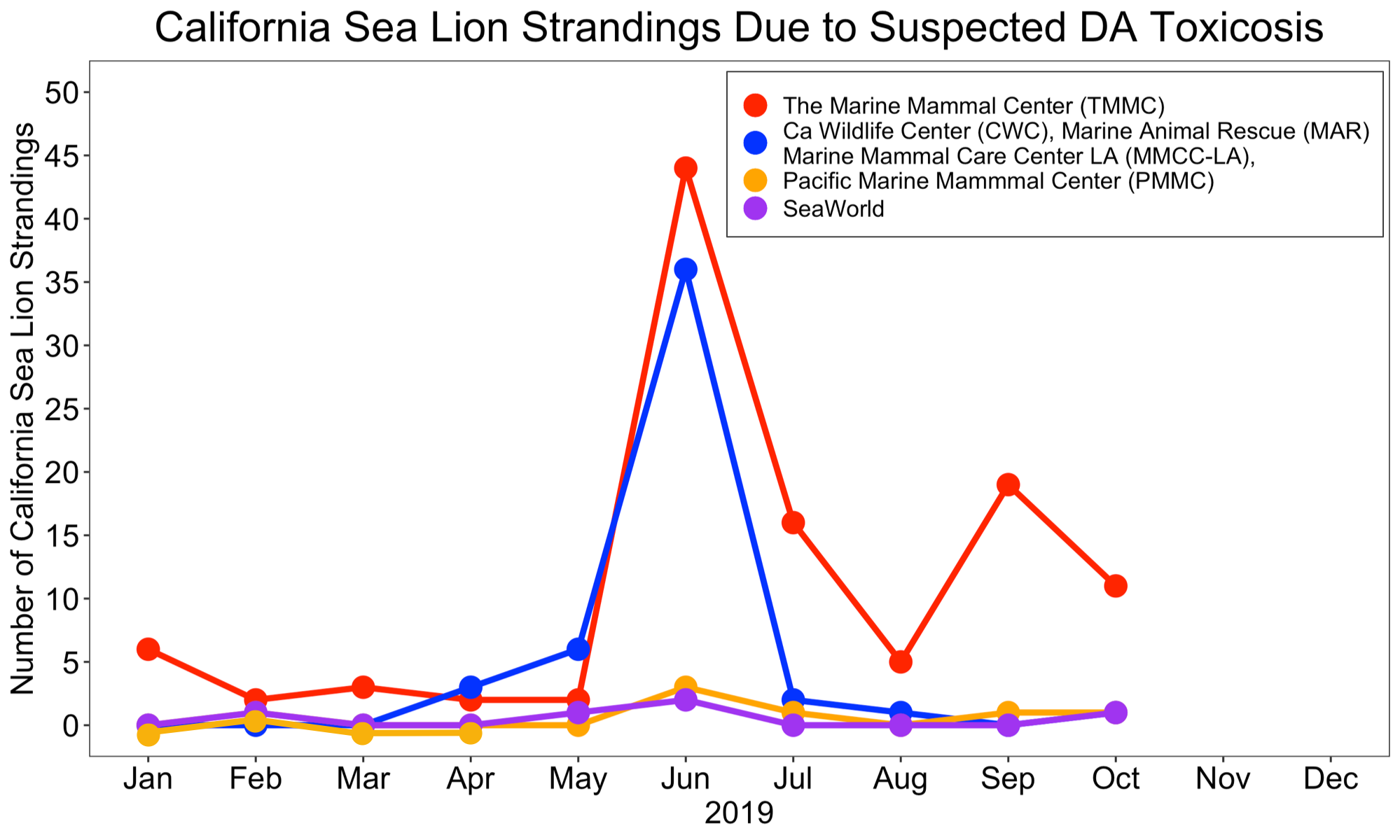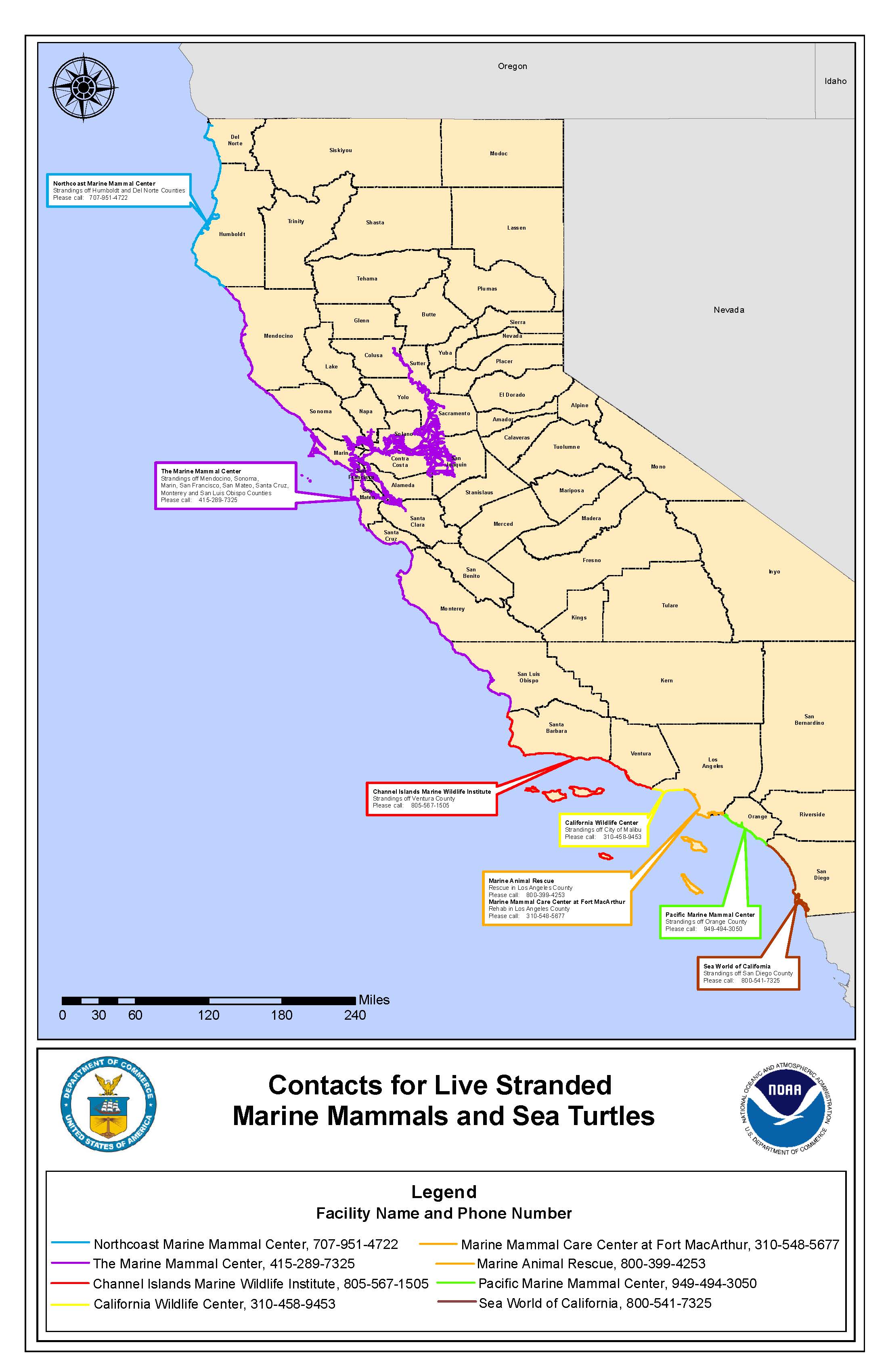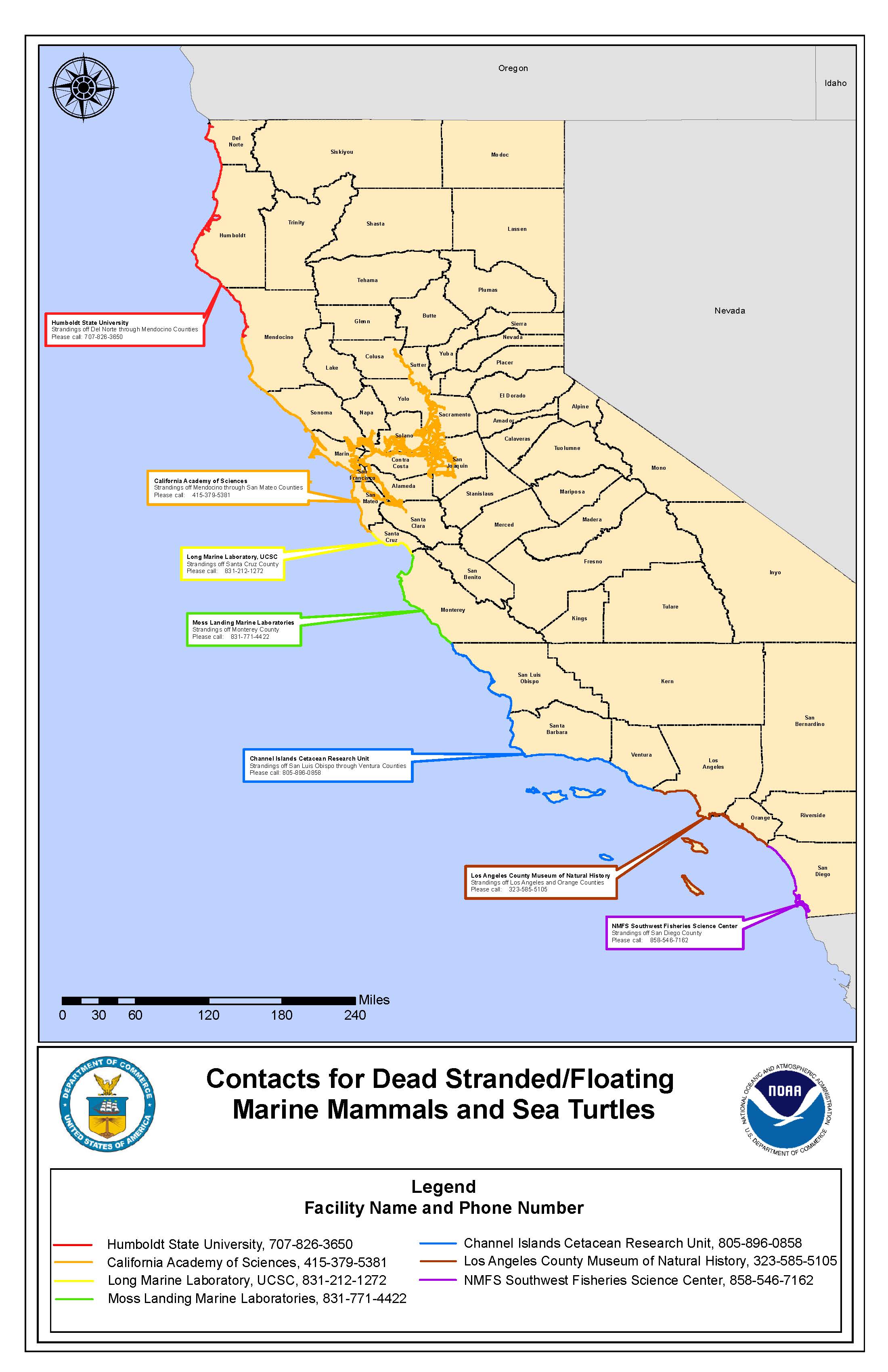Pseudo-nitzschia - C-HARM tells us where conditions are suitable for species of the diatom Pseudo-nitzschia spp. (all size classes) to grow well and where they might be more likely to produce domoic acid (DA). In October, suitable habitat for Pseudo-nitzschia spp. was spread throughout coastal California, as it has been for many months, but with only coastal ribbons of high probability in the Bight south of the Santa Barbara Channel. Habitat suitability increased in intensity in regions north of the Santa Barbara Channel. C-HARM predicted high but patchy probabilities of high particulate DA (pDA) throughout most of the state, with the greatest probabilities of pDA along sections of the Humboldt/North County coastline, Sonoma coastline, Half Moon Bay, the southern portion of Monterey Bay, and the Southern California Bight (including the Santa Barbara Channel and the transition region around Pt Conception). Those probabilities are notably low along the San Luis Obispo coastline, as they were in August and September, which seems inconsistent with the higher Pseudo-nitzschia spp. abundances measured by CDPH in that zone in October (discussed more below). Persistent high probabilities in the Bight south of the Santa Barbara Channel seem to be due to a two-year long salinity anomaly that is driving the pDA model to over-predict the probability of domoic acid, however, this is still under investigation. Salinity is not an important component of the cellular DA (cDA) model, and we do not see this pattern in the cDA model output. C-HARM indicates very high probabilities in cDA distributed in patches. These patches wax and wane over the course of the month but are persistently high along the Humboldt Coastlilne, Sonoma coastline and Marin County, the southern portion of Monterey Bay, just south of Monterey Bay, and around the Santa Barbara Channel Islands later in the month (as was the case in September).
In comparison with the Harmful Algal Bloom Monitoring and Alert Program (HABMAP) measurements where we have the October data currently available, bloom levels of the P. "delicatissima" and "seriata" size class occurred at various times throughout the month in the Southern California Bight at Scripps Pier (San Diego Co.), Newport Beach Pier (Orange Co.), and Stearns Wharf (Santa Barbara Co.), but not at the Santa Monica Pier (Los Angeles Co.). October domoic acid data were only currently available for the Santa Cruz Wharf and Newport Beach Pier where no domoic acid was detected. In the case of Newport Beach Pier, only the Pseudo-nitzschia delicatissima size class was blooming towards the end of October, and no Pseudo-nitzschia activity at the Santa Cruz Wharf. High C-HARM pDA probabilities in the southern Monterey Bay but not northern Monterey Bay are consistent with HABMAP time series showing little activity related to both Pseudo-nitzschia presence and DA at the Santa Cruz Wharf but showing bloom levels of both the "seriata" and "delicatissima" size classes at Monterey Wharf (south bay). High abundances of the more toxigenic Pseudo-nitzschia seriata size class at Scripps Pier and Newport Beach Pier are consistent with a high intensity ribbon of high probabilities along the coastline in the Bight as well as high pDA probabilities there. However, note the caveat regarding C-HARM pDA probabilities in the Bight mentioned above.
CDPH recorded their highest relative abundances of Pseudo-nitzschia seriata size class in Humboldt Bay area, northern Monterey Bay (in contrast to HABMAP results and the pDA model predictions from C-HARM), the Santa Barbara Channel (especially the north side of Santa Cruz Island), the Los Angeles and Orange County areas, as well as San Luis Obispo County. HABMAP also recorded a slight rise in the seriata size class of Pseudo-nitzschia with no associated pDA at the end of September, which corrobrates the CDPH observations. These results are generally consistent with the HABMAP patterns, with the exception of the Santa Cruz area. Most closures or advisories from CDPH related to the threat of Amnesic Shellfish Poisoning (ASP) from domoic acid took place in the Humboldt and Sonoma Counties on or after October 15th. The Dungeness crab fishery has been delayed due to both poor meat quality and the threat of ASP in some areas, notably Sonoma/Mendocino Counties. Marine mammal strandings from DA toxicosis were down in October from September and were only recorded along the central coast, although three from LA to San Diego are consistent with C-HARM predictions of high pDA probability in much of the Bight (even if possibly over-predicted) and moderate probabilites of cDA risk in the area. This does not mean there have not been North Coast strandings from DA toxicosis, only that we are not acquiring data from the North Coast Marina Mammal Center yet.
Alexandrium - There was no activity related to Alexandrium spp. or paralytic shellfish (PSP) toxins seen in HABMAP or CDPH records for October.
Note that data for some stations are not shown because they are not yet recorded in the public HABMAP archive.
Differentiating Pseudo-nitzschia species by light microscopy is difficult. For this reason, Pseudo-nitzschia "seriata" does not refer to an actual species but rather the larger size class of Pseudo-nitzschia, which is generally a more toxigenic group of species. Alternatively, Pseudo-nitzschia "delicatissima" refers to the smaller size class that is generally non-toxigenic. The dashed line on the plots demarcates the 10,000 cells/L "bloom" threshold designated here for Pseudo-nitzschia populations only.
More information on the statewide HAB network and forecasting system can be found here and on the SCCOOS HABMAP page.
Santa Cruz Wharf
Water samples were collected at Santa Cruz Wharf five times in the month of October. Pseudo-nitzschia seriata group was detected below bloom levels on October 9th and Alexandrium were detected below bloom levels on October 2nd. Domoic acid was not detected on October 2nd and the results for the water samples later in the month are not yet available. Santa Cruz Wharf does not count for Pseudo-nitzschia delicatissima group.
Monterey Wharf
Water samples were collected at Monterey Wharf five times in the month of October. Pseudo-nitzschia delicatissima was detected above bloom levels on October 9th and October 16th and Pseudo-nitzschia seriata was detected below bloom levels in all five samples. Alexandrium spp. were detected below bloom levels on October 20th. Domoic Acid results are not yet available for the month of October.
Cal Poly Pier
Cal Poly Pier phytoplankton counts and domoic acid results are not yet available for the month of October.
Stearns Wharf
Water samples were collected at Stearns Wharf four times in the month of October. Pseudo-nitzschia delicatissima group was detected above bloom levels on October 7th. Pseudo-nitzschia seriata group was detected below bloom levels in all four samples and Alexandrium spp. were not detected in any of the samples. Domoic Acid results are not yet available for Stearns Wharf.
Santa Monica Pier
Water samples were collected at Santa Monica Pier four times in the month of October. Pseudo-nitzschia delicatissima, Pseudo-nitzschia seriata and Alexandrium spp. were not detected above bloom levels in any of the October water samples and domoic acid results are not yet available for the month of October.
Newport Beach Pier
Water samples were collected at Newport Beach Pier five times in the month of October. Pseudo-nitzschia delicatissima group was detected above bloom levels on October 22nd, while Pseudo-nitzschia seriata group was detected below bloom. Alexandrium spp. and domoic acid were not detected in any of October water samples.
Scripps Pier
Water samples were collected two times at Scripps Pier in the month of October. Pseudo-nitzschia delicatissima was detected above bloom levels on October 7th and 14th. Pseudo-nitzschia seriata were detected below bloom levels and Alexandrium spp. were not detected in any of the water samples. Particulate domoic acid results are not yet available for Scripps Pier for June - October.
CDPH observations for Pseudo-nitzschia spp. and Alexandrium spp.
Please note CDPH recently moved to only reporting Pseudo-nitzschia of the seriata complex and not all Pseudo-nitzschia spp. as previously provided.
From 1-31 October 2019, water samples were collected by volunteers and sent to the California Department of Public Health (CDPH) for analysis. Pseudo-nitzschia seriata group were detected in 52 of the 102 samples. Pseudo-nitzschia seriata group were recorded at abundant density levels in three of the samples:
- October 6th, 2019 at Trinidad Pier (81% composition)
- October 7th, 2019 at Humboldt Bay (73% composition)
- October 15th, 2019 at Humboldt Bay (60% composition)
Pseudo-nitzschia seriata were also recorded at 8 sites with Common density levels. Alexandrium spp. were detected in 16 of 57 samples in the month of October at low density levels (<0.5% composition). You can also view CDPH weekly map layers of Pseudo-nitzschia and Alexandrium spp. here.
Data are provided by the California Department of Public Health, Environmental Management Branch.
CDPH and OEHHA Health Advisories
On November 1st, the California Department of Fish and Wildlife issued a delay in the California Dungeness crab fishery south of the Sonoma/Mendocino county line until December 14th due to potential whale entagelements from fishing gear. CDPH also released a warning for Amnesic Shellfish Poisoning (ASP) in mussels on October 15th due to the risk of domoic acid for Humboldt and Mendocino counties.The annual mussel quarantine remains in effect through October 31st.
For the latest closures and updates, please visit the CDFW Health Advisories page as a central location of information related to CDPH and/or OEHHA health advisories.
On July 30, 2019 the Office of Environmental Health Hazard Assessment (OEHHA) hosted the Domoic Acid Webinar: Research on Effects of Repeat Low-Level Exposures and Its Implications for Human Toxicity. The recorded webinar can be found here.
Domoic acid (DA) is a potent neurotoxin produced by some diatom species of the genus Pseudo-nitzschia. Species exposed to DA can result in seizures, epilepsy, cardiomyopathy, and death depending upon the ingested dose. DA toxicosis commonly occurs in California Sea Lions (Zalophus californianus), presumably due to a combination of foraging behavior and seasonal movements. The Marine Mammal Center (TMMC), the California Wildlife Center (CWC), the Marine Mammal Care Center Los Angeles (MMCC-LA), Marine Animal Rescue (MAR), the Pacific Marine Mammal Center (PMMC), and SeaWorld act like an emergency room by working to rescue and rehabilitate sick and injured marine mammals, seabirds, and sea turtles.
Among the six rehabilitation centers we have data for a total of 14 marine mammal strandings presented with symptoms of domoic acid toxicosis in the month of October.
October marine mammal strandings suspected due to DA toxicosis occurred in the following counties:
- Mendocino County (TMMC)
- October 8, juvenile male California Sea Lion
- Sonoma County (TMMC)
- October 4, juvenile male California Sea Lion
- San Francisco County (TMMC)
- October 3, subadult male California Sea Lion
- October 23, adult male California Sea Lion
- San Mateo County (TMMC)
- October 8, juvenile male California Sea Lion
- October 21, yearling male California Sea Lion
- Marin County (TMMC)
- October 3, yearling female California Sea Lion
- Monterey County (TMMC)
- October 11, yearling female California Sea Lion
- San Luis Obispo County (TMMC)
- October 7, adult female California Sea Lion
- October 28, adult female California Sea Lion
- October 28, adult female California Sea Lion
- Los Angeles County (CWC)
- October 19, adult female Striped dolphin
- Orange County (PMMC)
- October 4, adult female California Sea Lion
- San Diego County (SeaWorld)
- October 17, adult female California Sea Lion
At this time we do not have data from the North Coast Marine Mammal Center or the Channel Islands Marine Wildlife Institute.
California Sea Bird Strandings from Suspected DA Toxicosis
Data coming soon from Wildlife Rehabilitation Medical Database (WRMD) and BeachCOMBERS.
Please subscribe to CA HAB Bulletin listserv to receive the monthly CA HAB Bulletin.


